Assessing Agricultural Systems Using Emergy Analysis: A Bibliometric Review
Abstract
1. Introduction
2. Materials and Methods
2.1. Bibliometric Analysis
2.2. Agricultural Subsystems: An Overview of Emergy Indicators
3. Results
3.1. Overview of Research on Emergy Assessments
3.2. Journals
3.3. Authors Analysis
3.4. Country Contribution
3.5. Keyword Analysis
3.6. Scope of Analysis: Spatial Scale and Production Types
3.7. Agricultural Productions and Emergy Indicators
4. Discussion
4.1. Production Scales
4.2. Farm-Scale Emergy Indicators
4.3. Further Considerations
5. Conclusions
Supplementary Materials
Author Contributions
Funding
Data Availability Statement
Acknowledgments
Conflicts of Interest
References
- Helfenstein, J.; Diogo, V.; Bürgi, M.; Verburg, P.; Swart, R.; Mohr, F.; Debonne, N.; Levers, C.; Herzog, F. Chapter Five—Conceptualizing Pathways to Sustainable Agricultural Intensification. In The Future of Agricultural Landscapes, Part I; Bohan, D.A., Vanbergen, A.J., Eds.; Advances in Ecological Research; Academic Press: Cambridge, MA, USA, 2020; Volume 63, pp. 161–192. [Google Scholar]
- Hinz, R.; Sulser, T.B.; Huefner, R.; Mason-D’Croz, D.; Dunston, S.; Nautiyal, S.; Ringler, C.; Schuengel, J.; Tikhile, P.; Wimmer, F.; et al. Agricultural Development and Land Use Change in India: A Scenario Analysis of Trade-Offs Between UN Sustainable Development Goals (SDGs). Earth’s Future 2020, 8, e2019EF001287. [Google Scholar] [CrossRef]
- Tang, W.; Ao, L.; Zhang, H.; Shan, B. Accumulation and Risk of Heavy Metals in Relation to Agricultural Intensification in the River Sediments of Agricultural Regions. Environ. Earth Sci. 2014, 71, 3945–3951. [Google Scholar] [CrossRef]
- IRENA; FAO. Renewable Energy for Agri-Food Systems—Towards the Sustainable Development Goals and the Paris Agreement; IRENA: Masdar City, United Arab Emirates; FAO: Rome, Italy, 2021. [Google Scholar]
- Pimentel, D.; Hepperly, P.; Hanson, J.; Douds, D.; Seidel, R. Environmental, Energetic, and Economic Comparisons of Organic and Conventional Farming Systems. BioScience 2005, 55, 573–582. [Google Scholar] [CrossRef]
- Parajuli, R.; Dalgaard, T.; Birkved, M. Can Farmers Mitigate Environmental Impacts through Combined Production of Food, Fuel and Feed? A Consequential Life Cycle Assessment of Integrated Mixed Crop-Livestock System with a Green Biorefinery. Sci. Total Environ. 2018, 619–620, 127–143. [Google Scholar] [CrossRef]
- Berndes, G.; Hoogwijk, M.; van den Broek, R. The Contribution of Biomass in the Future Global Energy Supply: A Review of 17 Studies. Biomass Bioenergy 2003, 25, 1–28. [Google Scholar] [CrossRef]
- Deng, X.; Han, J.; Yin, F. Net Energy, CO2 Emission and Land-Based Cost-Benefit Analyses of Jatropha Biodiesel: A Case Study of the Panzhihua Region of Sichuan Province in China. Energies 2012, 5, 2150–2164. [Google Scholar] [CrossRef]
- Odum, H.T. Systems Ecology; An Introduction; John Wiley and Sons: New York, NY, USA, 1983. [Google Scholar]
- He, S.; Zhu, D.; Chen, Y.; Liu, X.; Chen, Y.; Wang, X. Application and Problems of Emergy Evaluation: A Systemic Review Based on Bibliometric and Content Analysis Methods. Ecol. Indic. 2020, 114, 106304. [Google Scholar] [CrossRef]
- Chen, W.; Liu, W.; Geng, Y.; Brown, M.T.; Gao, C.; Wu, R. Recent Progress on Emergy Research: A Bibliometric Analysis. Renew. Sustain. Energy Rev. 2017, 73, 1051–1060. [Google Scholar] [CrossRef]
- Xu, X.; Feng, C. Mapping the Knowledge Domain of the Evolution of Emergy Theory: A Bibliometric Approach. Environ. Sci. Pollut. Res. 2021, 28, 43114–43142. [Google Scholar] [CrossRef] [PubMed]
- Bravo-Toledo, L.; Barreto-Pio, C.; López Herrera, J.; Milla-Figueroa, C.; Pilco Nuñez, A.; Virú-Vásquez, P. Global Research Trends in Emergy and Wastewater Treatment: A Bibliometric Analysis. Environ. Res. Eng. Manag. 2023, 79, 16–36. [Google Scholar] [CrossRef]
- Zhang, C.; Su, B.; Beckmann, M.; Volk, M. Emergy-Based Evaluation of Ecosystem Services: Progress and Perspectives. Renew. Sustain. Energy Rev. 2024, 192, 114201. [Google Scholar] [CrossRef]
- Aria, M.; Cuccurullo, C. Bibliometrix: An R-Tool for Comprehensive Science Mapping Analysis. J. Informetr. 2017, 11, 959–975. [Google Scholar] [CrossRef]
- Page, M.J.; McKenzie, J.E.; Bossuyt, P.M.; Boutron, I.; Hoffmann, T.C.; Mulrow, C.D.; Shamseer, L.; Tetzlaff, J.M.; Akl, E.A.; Brennan, S.E.; et al. The PRISMA 2020 statement: An updated guideline for reporting systematic reviews. BMJ 2021, 372, n71. [Google Scholar] [CrossRef]
- Odum, H.T. Environmental Accounting: Emergy and Environmental Decision Making; John Wiley and Sons: New York, NY, USA, 1996. [Google Scholar]
- Brown, M.T.; Ulgiati, S. Emergy Assessment of Global Renewable Sources. Ecol. Model. 2016, 339, 148–156. [Google Scholar] [CrossRef]
- Scimago Journal & Country Rank. Available online: https://www.scimagojr.com/ (accessed on 11 July 2025).
- Zhang, J.; Yu, Q.; Zheng, F.; Azad, C.L.; Lu, Z.; Duan, Z. Comparing Keywords plus of WOS and Author Keywords: A Case Study of Patient Adherence Research. J. Assoc. Inf. Sci. Technol. 2015, 67, 967–972. [Google Scholar] [CrossRef]
- Benito Santos, A.; Therón, R. A Data-Driven Introduction to Authors, Readings and Techniques in Visualization for the Digital Humanities. IEEE Comput. Graph. Appl. 2020, 40, 45–57. [Google Scholar] [CrossRef] [PubMed]
- Peláez-Repiso, A.; Sánchez-Núñez, P.; García Calvente, Y. Tax Regulation on Blockchain and Cryptocurrency: The Implications for Open Innovation. J. Open Innov. Technol. Mark. Complex. 2021, 7, 98. [Google Scholar] [CrossRef]
- Callon, M.; Courtial, J.P.; Laville, F. Co-Word Analysis as a Tool for Describing the Network of Interactions between Basic and Technological Research: The Case of Polymer Chemsitry. Scientometrics 1991, 22, 155–205. [Google Scholar] [CrossRef]
- Buonocore, E.; Haeyhae, T.; Paletto, A.; Franzese, P.P. Assessing Environmental Costs and Impacts of Forestry Activities: A Multi-Method Approach to Environmental Accounting. Ecol. Model. 2014, 271, 10–20. [Google Scholar] [CrossRef]
- Cuadra, M.; Bjorklund, J. Assessment of Economic and Ecological Carrying Capacity of Agricultural Crops in Nicaragua. Ecol. Indic. 2007, 7, 133–149. [Google Scholar] [CrossRef]
- Lu, H.; Campbell, D.E. Ecological and Economic Dynamics of the Shunde Agricultural System under China’s Small City Development Strategy. J. Environ. Manag. 2009, 90, 2589–2600. [Google Scholar] [CrossRef]
- Principi, I.; Fugaro, L.; Borsa, S. Assessing Sustainability of the Chianti Area: The Role of Agriculture. In Ecosystems and Sustainable Development IV, Vols 1 and 2; Tiezzi, E., Brebbia, C., Uso, J., Eds.; WIT Press: Hampshire, UK, 2003; Volume 18–19, pp. 723–729. [Google Scholar]
- Takahashi, F.; Ortega, E. Assessing the Sustainability of Brazilian Oleaginous Crops—Possible Raw Material to Produce Biodiesel. Energy Policy 2010, 38, 2446–2454. [Google Scholar] [CrossRef]
- Ulgiati, S. A Comprehensive Energy and Economic Assessment of Biofuels: When “Green” Is Not Enough. Crit. Rev. Plant Sci. 2001, 20, 71–106. [Google Scholar] [CrossRef]
- ISAER—International Society for the Advancement of Emergy Research|The Official Website of the Emergy Society—ISAER. Available online: https://www.emergysociety.com/ (accessed on 11 July 2025).
- Cuadra, M.; Rydberg, T. Emergy Evaluation on the Production, Processing and Export of Coffee in Nicaragua. Ecol. Model. 2006, 196, 421–433. [Google Scholar] [CrossRef]
- Cavalett, O.; Ortega, E. Emergy, Nutrients Balance, and Economic Assessment of Soybean Production and Industrialization in Brazil. J. Clean. Prod. 2009, 17, 762–771. [Google Scholar] [CrossRef]
- Chen, G.Q.; Jiang, M.M.; Chen, B.; Yang, Z.F.; Lin, C. Emergy Analysis of Chinese Agriculture. Agric. Ecosyst. Environ. 2006, 115, 161–173. [Google Scholar] [CrossRef]
- Gasparatos, A. Resource Consumption in Japanese Agriculture and Its Link to Food Security. Energy Policy 2011, 39, 1101–1112. [Google Scholar] [CrossRef]
- Zhong, S.; Geng, Y.; Kong, H.; Liu, B.; Tian, X.; Chen, W.; Qian, Y.; Ulgiati, S. Emergy-Based Sustainability Evaluation of Erhai Lake Basin in China. J. Clean. Prod. 2018, 178, 142–153. [Google Scholar] [CrossRef]
- Wang, G.; Yang, D.; Zhang, X. Emergy Evaluation of Agriculture System in Oasis-Desert Region: Tarim River Basin Case Study. In Proceedings of the 2012 Third International Conference on Digital Manufacturing Automation, Guilin, China, 31 July–2 August 2012; pp. 384–387. [Google Scholar]
- Oliveira, M.; Zucaro, A.; Santagata, R.; Ulgiati, S. Environmental Assessment of Milk Production from Local to Regional Scales. Ecol. Model. 2022, 463, 109795. [Google Scholar] [CrossRef]
- Kocjančič, T.; Debeljak, M.; Žgajnar, J.; Juvančič, L. Incorporation of Emergy into Multiple-Criteria Decision Analysis for Sustainable and Resilient Structure of Dairy Farms in Slovenia. Agric. Syst. 2018, 164, 71–83. [Google Scholar] [CrossRef]
- Rydberg, T.; Haden, A.C. Emergy Evaluations of Denmark and Danish Agriculture: Assessing the Influence of Changing Resource Availability on the Organization of Agriculture and Society. Agric. Ecosyst. Environ. 2006, 117, 145–158. [Google Scholar] [CrossRef]
- Cohen, M.J.; Brown, M.T.; Shepherd, K.D. Estimating the Environmental Costs of Soil Erosion at Multiple Scales in Kenya Using Emergy Synthesis. Agric. Ecosyst. Environ. 2006, 114, 249–269. [Google Scholar] [CrossRef]
- Zhang, L.-X.; Hu, Q.-H.; Wang, C.-B. Emergy Evaluation of Environmental Sustainability of Poultry Farming That Produces Products with Organic Claims on the Outskirts of Mega-Cities in China. Ecol. Eng. 2013, 54, 128–135. [Google Scholar] [CrossRef]
- Wang, Q.; Zhang, Y.; Tian, S.; Yuan, X.; Ma, Q.; Liu, M.; Li, Y.; Liu, J. Evaluation and Optimization of a Circular Economy Model Integrating Planting and Breeding Based on the Coupling of Emergy Analysis and Life Cycle Assessment. Environ. Sci. Pollut. Res. 2021, 28, 62407–62420. [Google Scholar] [CrossRef]
- Martin, G.; Moraine, M.; Ryschawy, J.; Magne, M.-A.; Asai, M.; Sarthou, J.-P.; Duru, M.; Therond, O. Crop–Livestock Integration beyond the Farm Level: A Review. Agron. Sustain. Dev. 2016, 36, 53. [Google Scholar] [CrossRef]
- Buller, L.S.; Bergier, I.; Ortega, E.; Moraes, A.; Bayma-Silva, G.; Zanetti, M.R. Soil Improvement and Mitigation of Greenhouse Gas Emissions for Integrated Crop-Livestock Systems: Case Study Assessment in the Pantanal Savanna Highland, Brazil. Agric. Syst. 2015, 137, 206–219. [Google Scholar] [CrossRef]
- Li, Y.; Sun, Z.; Accatino, F.; Hang, S.; Lv, Y.; Ouyang, Z. Comparing Specialised Crop and Integrated Crop-Livestock Systems in China with a Multi-Criteria Approach Using the Emergy Method. J. Clean. Prod. 2021, 314, 127974. [Google Scholar] [CrossRef]
- Ryschawy, J.; Choisis, N.; Choisis, J.P.; Joannon, A.; Gibon, A. Mixed Crop-Livestock Systems: An Economic and Environmental-Friendly Way of Farming? Animal 2012, 6, 1722–1730. [Google Scholar] [CrossRef] [PubMed]
- Moonilall, N.; Homenauth, O.; Lal, R. Emergy Analysis for Maize Fields under Different Amendment Applications in Guyana. J. Clean. Prod. 2020, 258, 120761. [Google Scholar] [CrossRef]
- Brown, M.T.; Ulgiati, S. Emergy Analysis and Environmental Accounting. Encycl. Energy 2004, 2, 329–354. [Google Scholar]
- Asgharipour, M.R.; Shahgholi, H.; Campbell, D.E.; Khamari, I.; Ghadiri, A. Comparison of the Sustainability of Bean Production Systems Based on Emergy and Economic Analyses. Environ. Monit. Assess. 2019, 191, 2. [Google Scholar] [CrossRef]
- Bravo Amarante, E.; Schulz, R.K.; Romero Romero, O.; Lopez Bastida, E.J.; Patricia Guereca, L. Emergy Analysis The Management of Rice Straw for Energy Purposes. Rev. Univ. Soc. 2021, 13, 404–420. [Google Scholar]
- Cavalett, O.; Queiroz, J.F.D.; Ortega, E. Emergy Assessment of Integrated Production Systems of Grains, Pig and Fish in Small Farms in the South Brazil. Ecol. Model. 2006, 193, 205–224. [Google Scholar] [CrossRef]
- Brown, M.T.; Ulgiati, S. Assessing the Global Environmental Sources Driving the Geobiosphere: A Revised Emergy Baseline. Ecol. Model. 2016, 339, 126–132. [Google Scholar] [CrossRef]
- Campbell, D.E. Emergy Baseline for the Earth: A Historical Review of the Science and a New Calculation. Ecol. Model. 2016, 339, 96–125. [Google Scholar] [CrossRef]
- De Vilbiss, C.; Brown, M.T.; Siegel, E.; Arden, S. Computing the Geobiosphere Emergy Baseline: A Novel Approach. Ecol. Model. 2016, 339, 133–139. [Google Scholar] [CrossRef]
- Hudson, A.; Tilley, D.R. Assessment of Uncertainty in Emergy Evaluations Using Monte Carlo Simulations. Ecol. Model. 2014, 271, 52–61. [Google Scholar] [CrossRef]
- Oliveira, M. Beijing Normal University and Tiangong LCA Platform Jointly Launch Global “Unit Emergy Value Database”. Available online: https://www.emergysociety.com/beijing-normal-university-and-tiangong-lca-platform-jointly-launch-global-unit-emergy-value-database/ (accessed on 11 August 2025).
- Gao, J.; Chen, D.; Luo, Z.; Dai, X.; Duan, J. Analysis of the current status and hotspots of emergy research based on bibliometrics. Ecol. Indic. 2025, 178, 113876. [Google Scholar] [CrossRef]
- Cui, J.; Sui, P.; Wright, D.L.; Wang, D.; Yang, J.; Lv, Z.; Chen, Y. A Revised Integrated Framework to Evaluate the Sustainability of given Cropping Systems. J. Clean. Prod. 2021, 289, 125716. [Google Scholar] [CrossRef]
- Amiri, Z.; Asgharipour, M.R.; Campbell, D.E.; Armin, M. A Sustainability Analysis of Two Rapeseed Farming Ecosystems in Khorramabad, Iran, Based on Emergy and Economic Analyses. J. Clean. Prod. 2019, 226, 1051–1066. [Google Scholar] [CrossRef]
- Amiri, Z.; Asgharipour, M.R.; Campbell, D.E.; Azizi, K.; Kakolvand, E.; Hassani Moghadam, E. Conservation Agriculture, a Selective Model Based on Emergy Analysis for Sustainable Production of Shallot as a Medicinal-Industrial Plant. J. Clean. Prod. 2021, 292, 12600. [Google Scholar] [CrossRef]
- Wang, L.; Li, L.; Cheng, K.; Ji, C.; Yue, Q.; Bian, R.; Pan, G. An Assessment of Emergy, Energy, and Cost-Benefits of Grain Production over 6 Years Following a Biochar Amendment in a Rice Paddy from China. Environ. Sci. Pollut. Res. 2018, 25, 9683–9696. [Google Scholar] [CrossRef]
- Wei, X.M.; Chen, B.; Qu, Y.H.; Lin, C.; Chen, G.Q. Emergy Analysis for “Four in One” Peach Production System in Beijing. Commun. Nonlinear Sci. Numer. Simul. 2009, 14, 946–958. [Google Scholar] [CrossRef]
- Wang, X.; Chen, Y.; Sui, P.; Gao, W.; Qin, F.; Zhang, J.; Wu, X. Emergy Analysis of Grain Production Systems on Large-Scale Farms in the North China Plain Based on LCA. Agric. Syst. 2014, 128, 66–78. [Google Scholar] [CrossRef]
- Khalaf, D.; Metzidakis, J.; Sfakiotakis, E.; Ortega, E. Emergy Analysis of Irrigated Organic and Conventional Production of Olive and Olive Oil in Crete, Greece “Preliminary Study”. In International Symposium on the Horizons of Using Organic Matter Substrates in Horticulture; AbouHadid, A.F., Ed.; International Society Horticultural Science: Leuven, Belgium, 2003; pp. 199–205. [Google Scholar]
- Zhao, Z.; Chen, J.; Bai, Y.; Wang, P. Assessing the Sustainability of Grass-Based Livestock Husbandry in Hulun Buir, China. Phys. Chem. Earth 2020, 120, 102907. [Google Scholar] [CrossRef]
- Rodríguez-Ortega, T.; Bernués, A.; Olaizola, A.M.; Brown, M.T. Does Intensification Result in Higher Efficiency and Sustainability? An Emergy Analysis of Mediterranean Sheep-Crop Farming Systems. J. Clean. Prod. 2017, 144, 171–179. [Google Scholar] [CrossRef]
- Fonseca, A.M.P.; Marques, C.A.F.; Pinto-Correia, T.; Campbell, D.E. Emergy Analysis of a Silvo-Pastoral System, a Case Study in Southern Portugal. Agrofor. Syst. 2016, 90, 137–157. [Google Scholar] [CrossRef]
- Guan, F.; Sha, Z.; Zhang, Y.; Wang, J.; Wang, C. Emergy Assessment of Three Home Courtyard Agriculture Production Systems in Tibet Autonomous Region, China. J. Zhejiang Univ.-Sci. B 2016, 17, 628–639. [Google Scholar] [CrossRef] [PubMed]
- Hu, Y. Emergy Evaluation of a Dairy-Mushroom Ecosystem in Miyun Reservoir Catchment of Beijing. In Proceedings of the 2015 Aasri International Conference on Circuits and Systems (CAS 2015), Paris, France, 9–10 August 2025; Elatter, E.E., Tsai, S.B., Eds.; Atlantis Press: Paris, France, 2015; Volume 9, pp. 129–134. [Google Scholar]
- Vigne, M.; Peyraud, J.-L.; Lecomte, P.; Corson, M.S.; Wilfart, A. Emergy Evaluation of Contrasting Dairy Systems at Multiple Levels. J. Environ. Manag. 2013, 129, 44–53. [Google Scholar] [CrossRef] [PubMed]
- Xi, Y.-G.; Qin, P. Emergy Evaluation of Organic Rice-Duck Mutualism System. Ecol. Eng. 2009, 35, 1677–1683. [Google Scholar] [CrossRef]
- Yun, L.; Li, J.; Hou, R.; Sun, Z.; Cong, P.; Liang, R.; Hang, S.; Gong, H.; Ouyang, Z. Emergy-Based Sustainability Analysis of an Ecologically Integrated Model with Maize Planting for Silage and Pig-Raising in the North China Plain. Sustainability 2019, 11, 6485. [Google Scholar] [CrossRef]
- Dong, X.; Brown, M.T.; Pfahler, D.; Ingwersen, W.W.; Kang, M.; Jin, Y.; Yu, B.; Zhang, X.; Ulgiati, S. Carbon Modeling and Emergy Evaluation of Grassland Management Schemes in Inner Mongolia. Agric. Ecosyst. Environ. 2012, 158, 49–57. [Google Scholar] [CrossRef]
- Dos Reis, B.Q.; Moreno, D.A.R.; Nacimento, R.A.; Luiz, V.T.; Alves, L.K.S.; Giannetti, B.F.; Gameiro, A.H. Economic and Environmental Assessment Using Emergy of Sheep Production in Brazil. Sustainability 2021, 13, 11595. [Google Scholar] [CrossRef]
- Wang, X.; Wu, X.; Yan, P.; Gao, W.; Chen, Y.; Sui, P. Integrated Analysis on Economic and Environmental Consequences of Livestock Husbandry on Different Scale in China. J. Clean. Prod. 2016, 119, 1–12. [Google Scholar] [CrossRef]
- Alfaro-Arguello, R.; Diemont, S.A.W.; Ferguson, B.G.; Martin, J.F.; Nahed-Toral, J.; Alvarez-Solis, J.D.; Pinto Ruiz, R. Steps toward Sustainable Ranching: An Emergy Evaluation of Conventional and Holistic Management in Chiapas, Mexico. Agric. Syst. 2010, 103, 639–646. [Google Scholar] [CrossRef]
- Castellini, C.; Bastianoni, S.; Granai, C.; Dal Bosco, A.; Brunetti, M. Sustainability of Poultry Production Using the Emergy Approach: Comparison of Conventional and Organic Rearing Systems. Agric. Ecosyst. Environ. 2006, 114, 343–350. [Google Scholar] [CrossRef]
- Zhang, L.X.; Song, B.; Chen, B. Emergy-Based Analysis of Four Farming Systems: Insight into Agricultural Diversification in Rural China. J. Clean. Prod. 2012, 28, 33–44. [Google Scholar] [CrossRef]
- Hu, Q.H.; Zhang, L.X.; Wang, C.B. Emergy-Based Analysis of Two Chicken Farming Systems: A Perception of Organic Production Model in China. In Proceedings of the 18th Biennial Isem Conference on Ecological Modelling for Global Change and Coupled Human and Natural System, Beijing, China, 20–23 September 2012; Yang, Z., Chen, B., Eds.; Elsevier Science Bv: Amsterdam, The Netherlands, 2012; Volume 13, pp. 445–454. [Google Scholar]
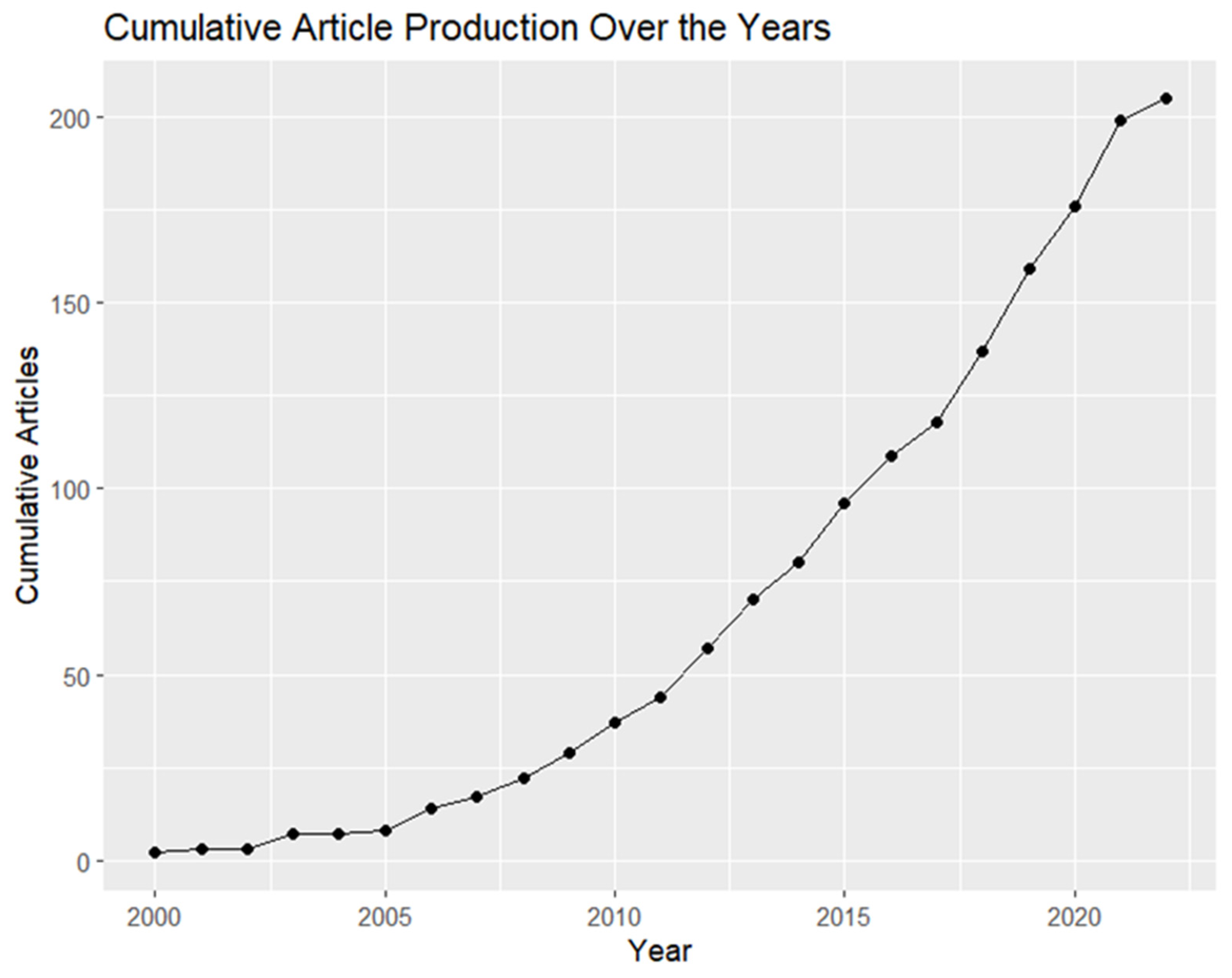
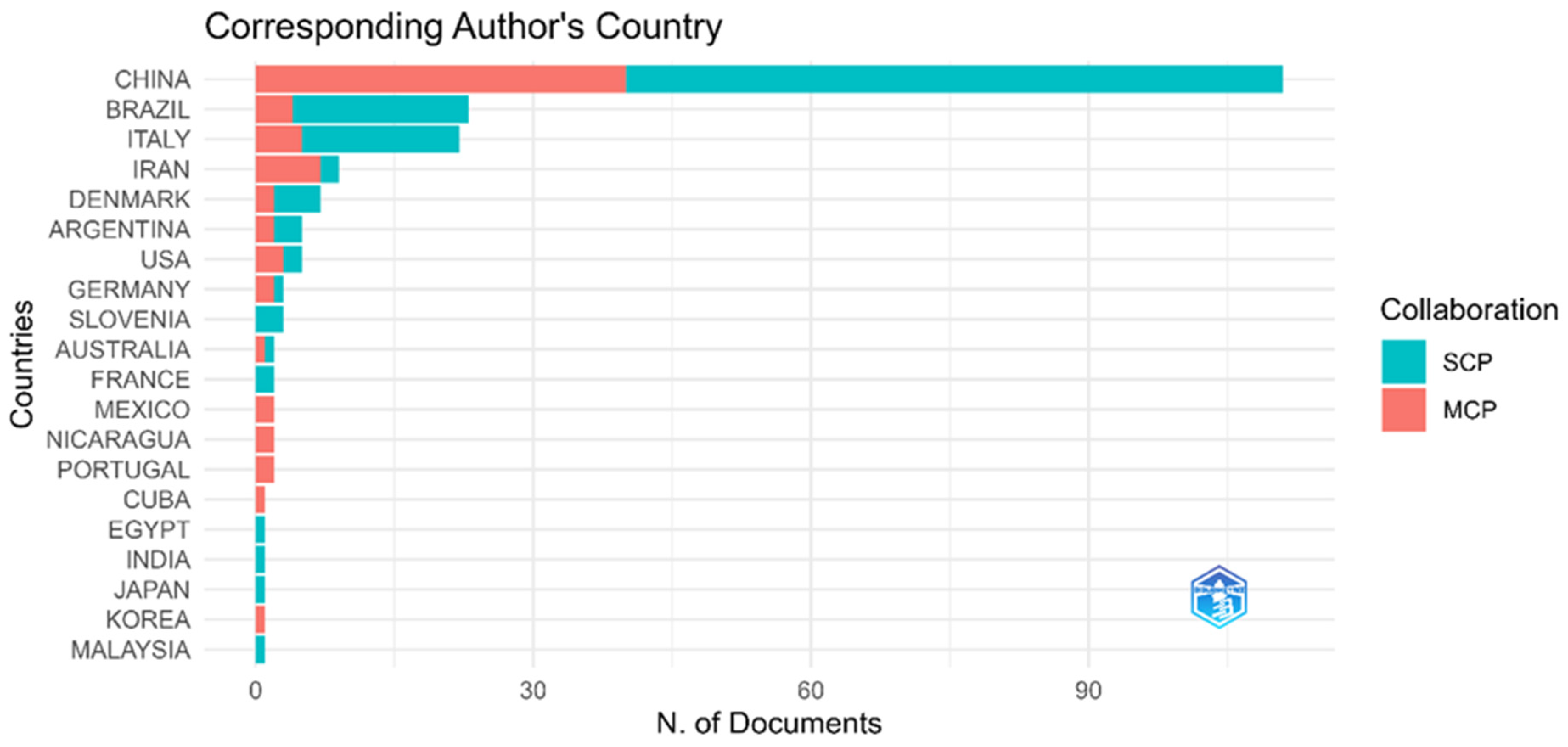

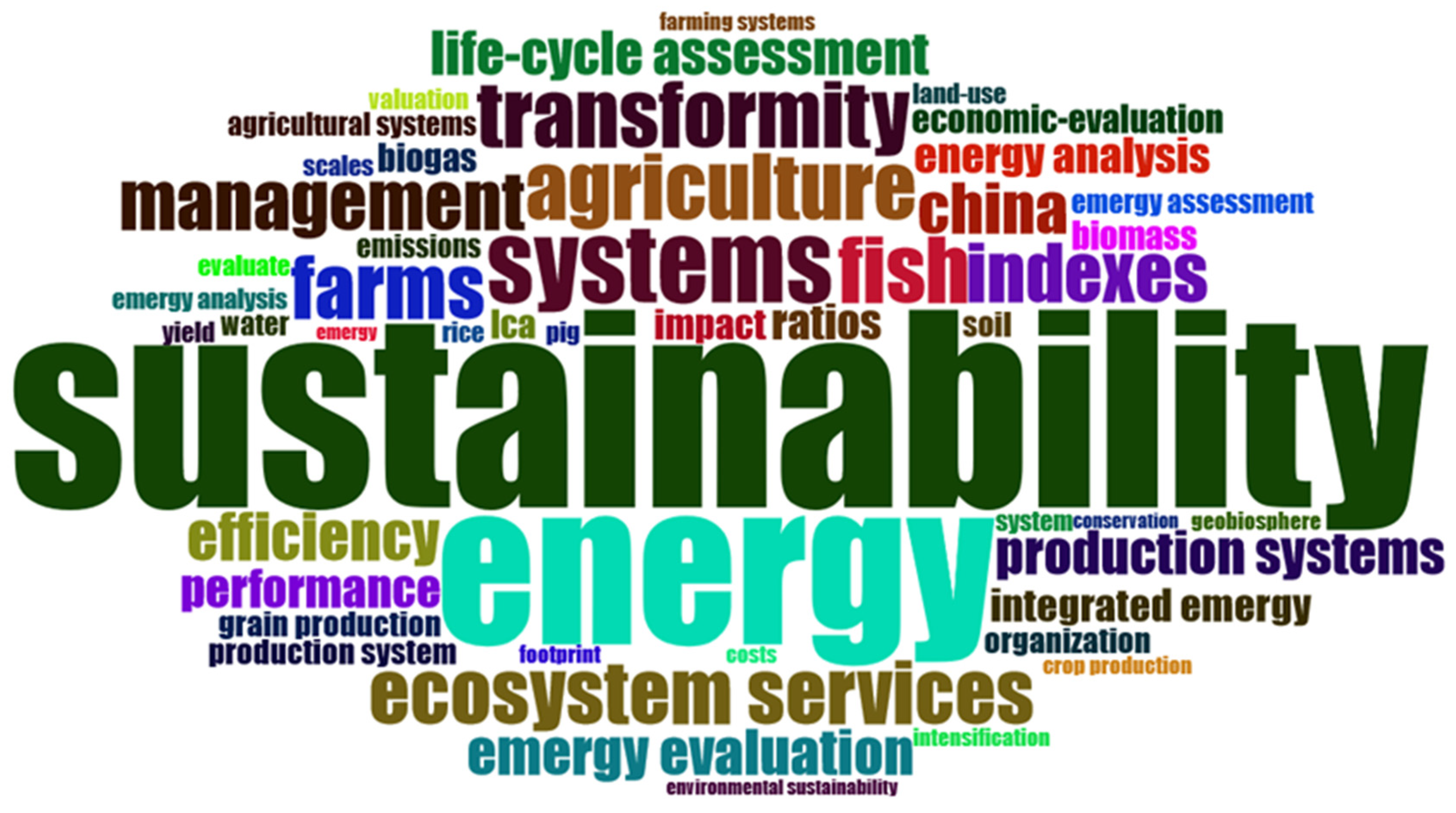
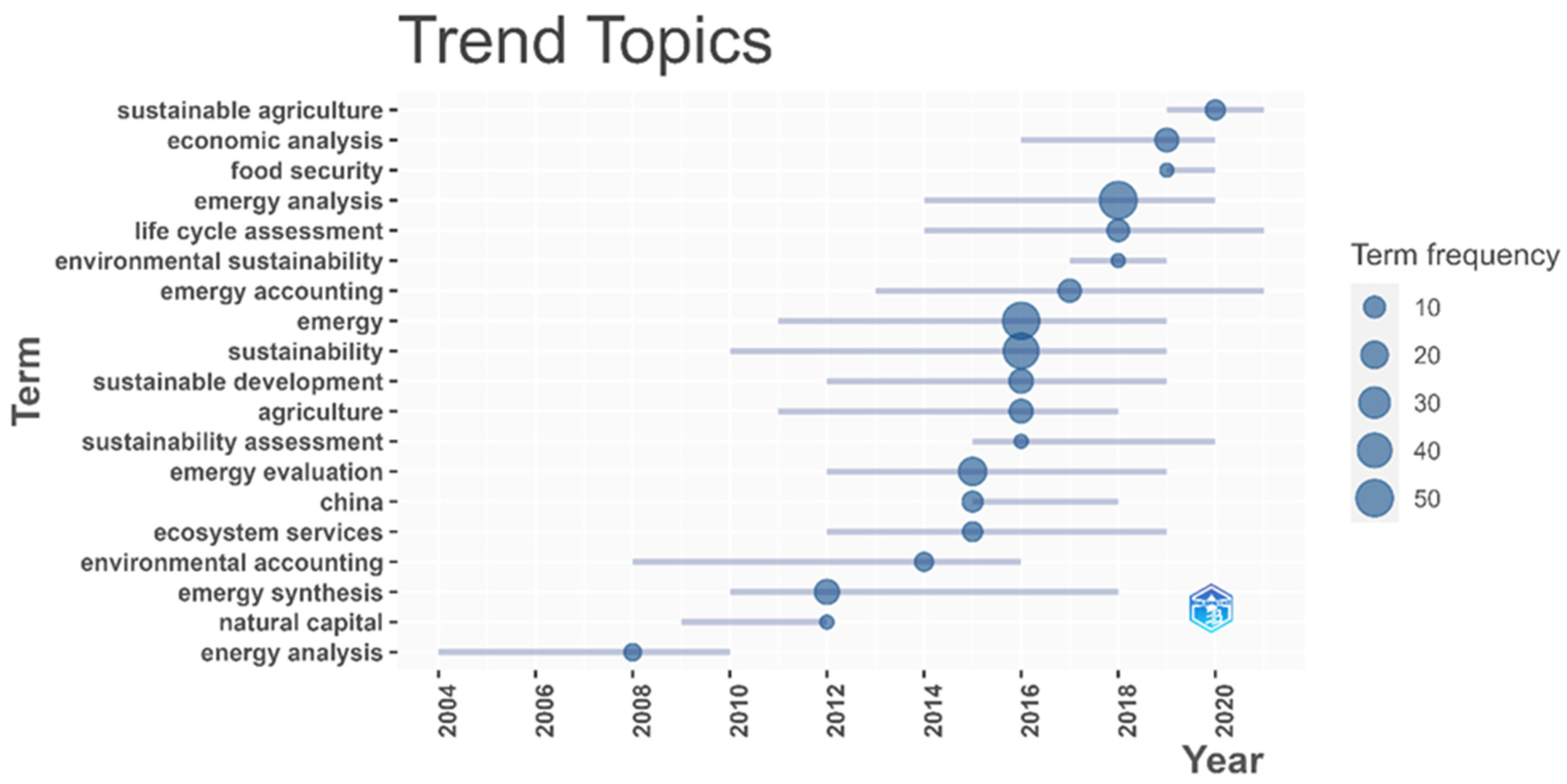
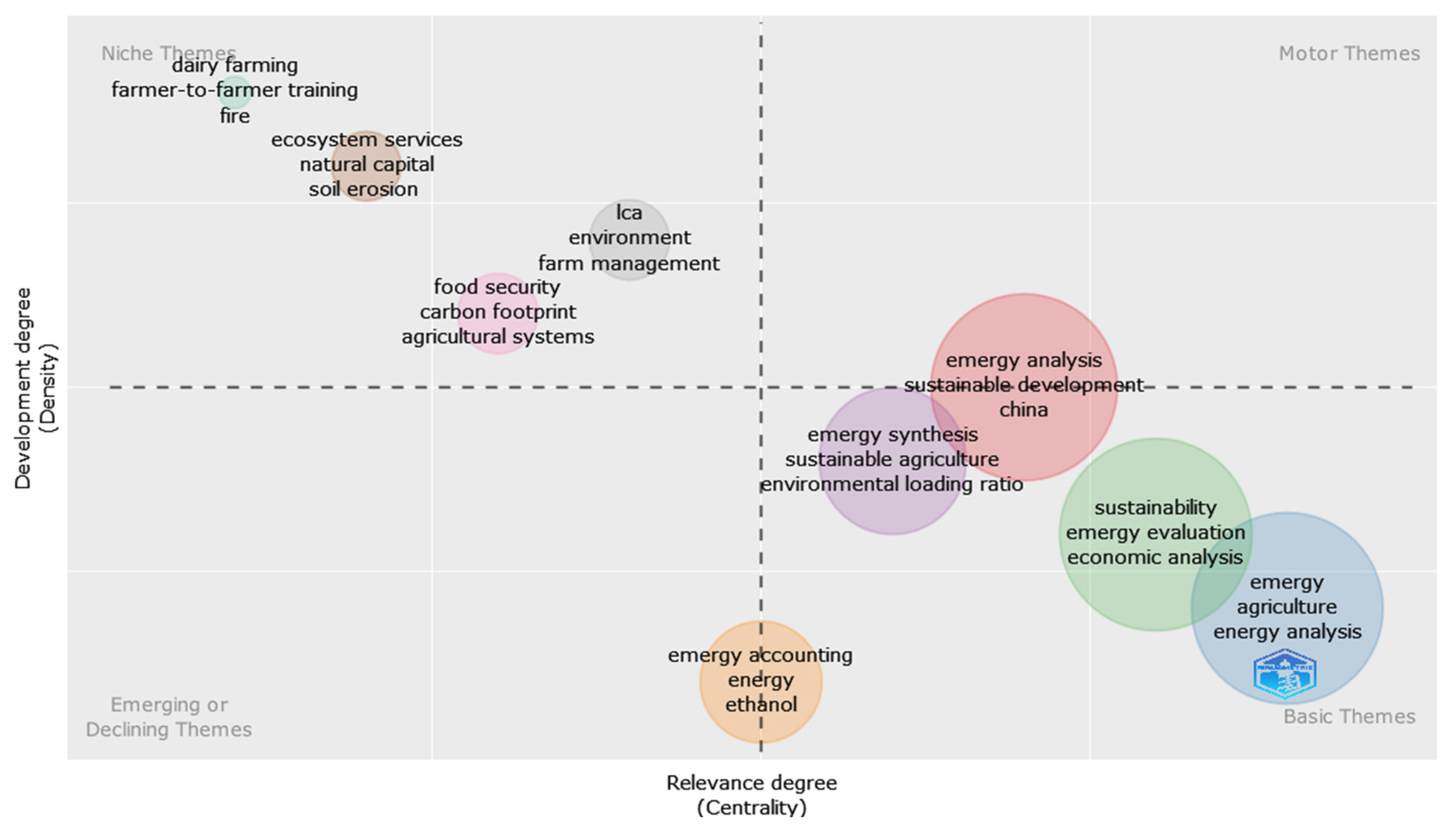
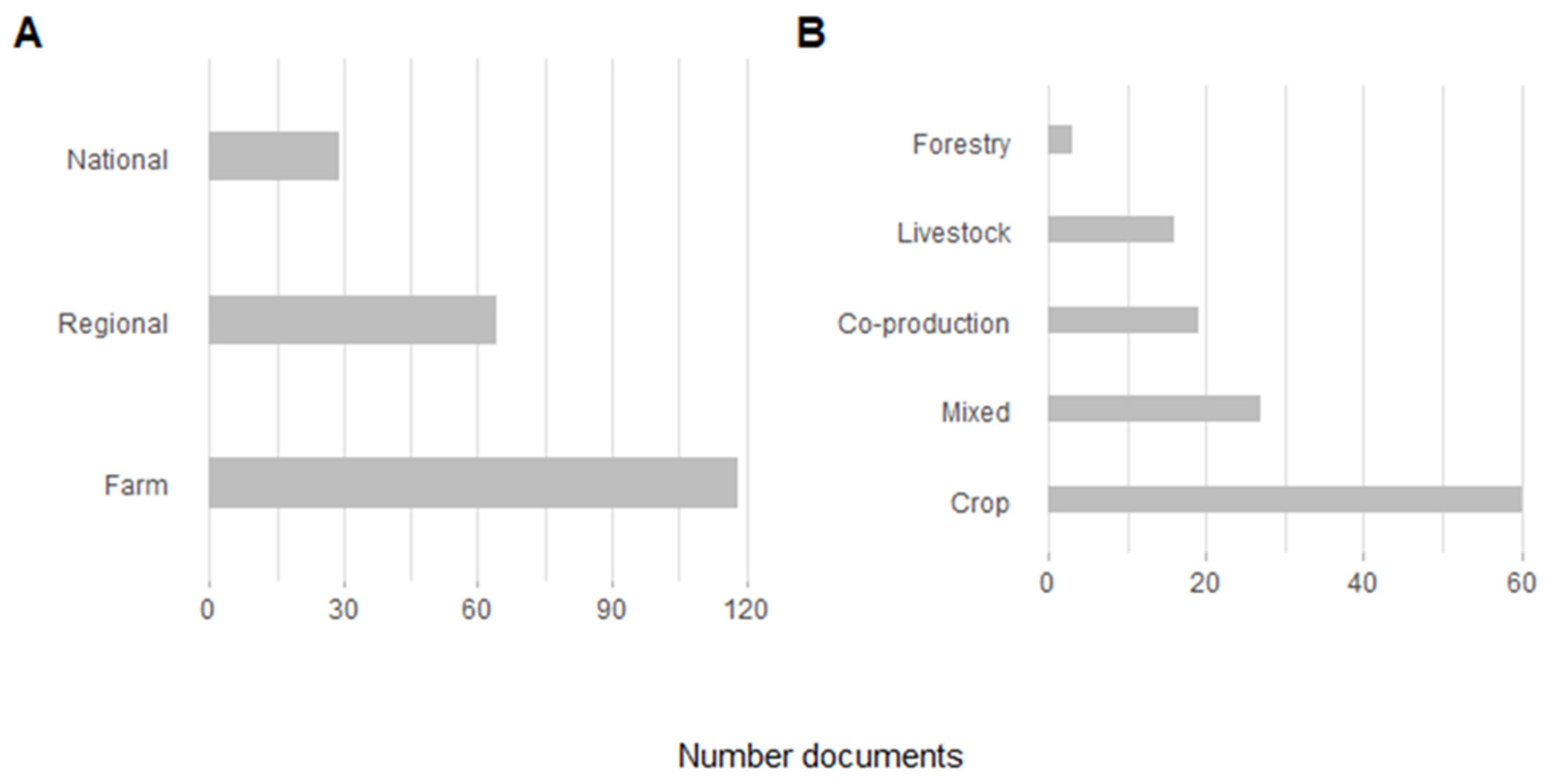
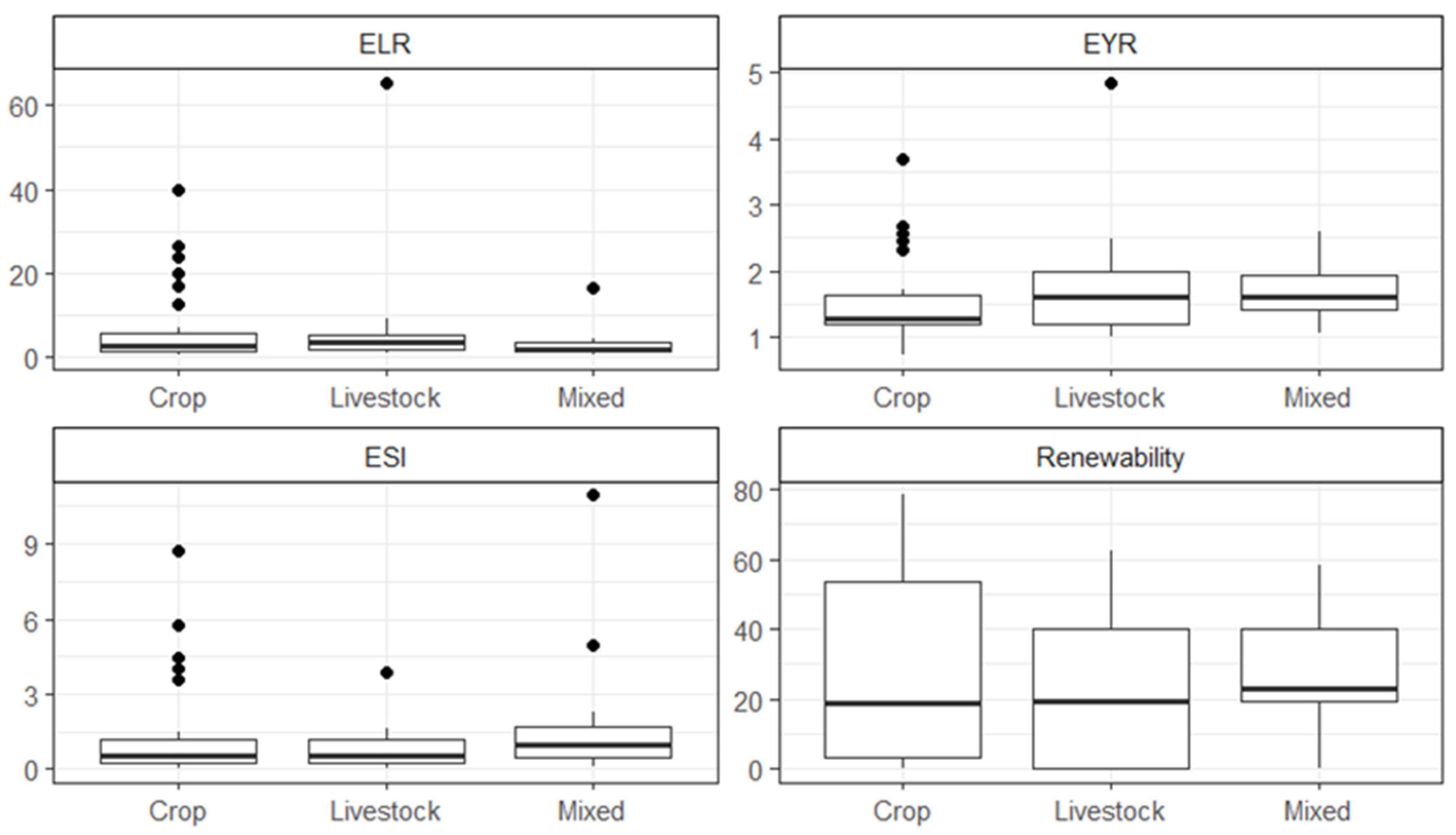
| Indicator | Expression | Description |
|---|---|---|
| Emergy Yield Ratio (EYR) | Y/F | The EYR measures the net contribution of a process to the economy beyond what is required for its own operation [17] and is the result of dividing the outputs emergy (Y) by the purchased emergy (F). |
| Environmental Loading Ratio (ELR) | (F+N)/R | The ecosystem’s stress related to the production activity can be evaluated through the ELR, calculated by dividing the non-renewable inputs (N) and F by renewable inputs (R). |
| Emergy Sustainability Index (ESI) | EYR/ELR | The ratio between EYR and ELR yields the sustainability index, which indicates if a process provides a suitable contribution to the user with a low environmental pressure [18]. |
| Renewability (R%) | R/Y | Renewability of a system indicates the quantity of renewable resources required by the production system to produce its output. |
| Sources | Articles (%) | h-Index | TC | PY Start | IF |
|---|---|---|---|---|---|
| Journal of Cleaner Production (n = 45) | 21.5 | 21 | 1005 | 2008 | 11.1 |
| Ecological Indicators (n = 16) | 7. | 12 | 478 | 2007 | 6.3 |
| Ecological Modelling (n = 16) | 7.7 | 11 | 744 | 2007 | 3.0 |
| Sustainability (n = 14) | 6.7 | 6 | 93 | 2007 | 3.9 |
| Ecological Engineering (n = 9) | 4.3 | 9 | 226 | 2000 | 4.4 |
| Agricultural Systems (n = 8) | 3.8 | 7 | 220 | 2009 | 6.7 |
| Agriculture Ecosystems & Environment (n = 7) | 3.4 | 7 | 558 | 2010 | 5.6 |
| Energy Policy (n = 7) | 3.4 | 7 | 333 | 2006 | 6.1 |
| Environmental Science and Pollution Research (n = 3) | 2.4 | 2 | 28 | 2018 | 5.2 |
| Renewable and Sustainable Energy Reviews (n = 5) | 2.4 | 3 | 104 | 2010 | 16.8 |
| Authors | Institution | Articles (%) | Authors | h-Index | TC | PY Start |
|---|---|---|---|---|---|---|
| Wang X | China Agr Uni. | 9.1 | Ulgiati S | 11 | 539 | 2001 |
| Ulgiati S | Uni. Siena | 6.2 | Ortega E | 10 | 585 | 2003 |
| Campbell D | Uni. Rhode Island | 5.7 | Wang X | 10 | 344 | 2014 |
| Ortega E | Uni. Estadual de Campinas | 5.7 | Chen B | 8 | 566 | 2006 |
| Chen Y | Nanjing Agr Uni. | 4.8 | Campbell D | 7 | 200 | 2009 |
| Giannetti B | Uni. Paulista | 4.3 | Chen Y | 7 | 238 | 2014 |
| Agostinho F | Uni. Estadual de Campinas | 3.8 | Wu X | 7 | 296 | 2013 |
| Chen B | Beijing Normal Uni. | 3.8 | Zhang X | 7 | 237 | 2008 |
| Wu X | Northwest AANDF Uni. | 3.8 | Zhang Y | 6 | 143 | 2011 |
| Zhang X | Wuhan Uni. of Science and Technology | 3.8 | Agostinho F | 5 | 202 | 2008 |
Disclaimer/Publisher’s Note: The statements, opinions and data contained in all publications are solely those of the individual author(s) and contributor(s) and not of MDPI and/or the editor(s). MDPI and/or the editor(s) disclaim responsibility for any injury to people or property resulting from any ideas, methods, instructions or products referred to in the content. |
© 2025 by the authors. Licensee MDPI, Basel, Switzerland. This article is an open access article distributed under the terms and conditions of the Creative Commons Attribution (CC BY) license (https://creativecommons.org/licenses/by/4.0/).
Share and Cite
Marinheiro, J.; Serra, J.; Fonseca, A.; Marques-dos-Santos, C.S.C. Assessing Agricultural Systems Using Emergy Analysis: A Bibliometric Review. Agronomy 2025, 15, 2110. https://doi.org/10.3390/agronomy15092110
Marinheiro J, Serra J, Fonseca A, Marques-dos-Santos CSC. Assessing Agricultural Systems Using Emergy Analysis: A Bibliometric Review. Agronomy. 2025; 15(9):2110. https://doi.org/10.3390/agronomy15092110
Chicago/Turabian StyleMarinheiro, Joana, João Serra, Ana Fonseca, and Cláudia S. C. Marques-dos-Santos. 2025. "Assessing Agricultural Systems Using Emergy Analysis: A Bibliometric Review" Agronomy 15, no. 9: 2110. https://doi.org/10.3390/agronomy15092110
APA StyleMarinheiro, J., Serra, J., Fonseca, A., & Marques-dos-Santos, C. S. C. (2025). Assessing Agricultural Systems Using Emergy Analysis: A Bibliometric Review. Agronomy, 15(9), 2110. https://doi.org/10.3390/agronomy15092110








